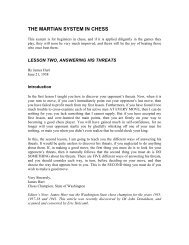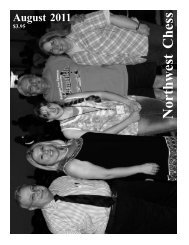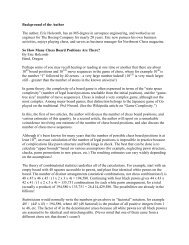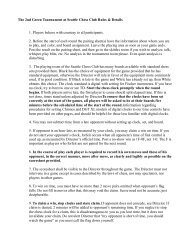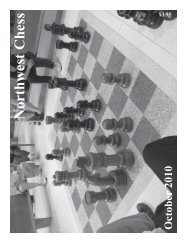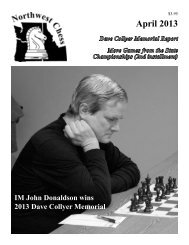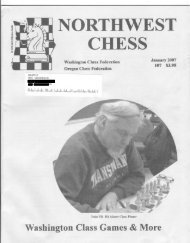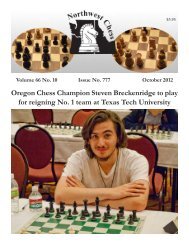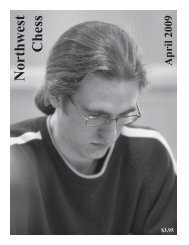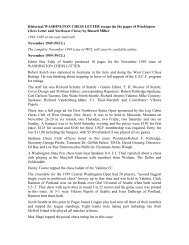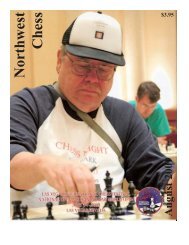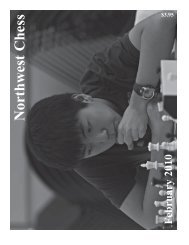January, 2012 - Idaho Chess Association
January, 2012 - Idaho Chess Association
January, 2012 - Idaho Chess Association
Create successful ePaper yourself
Turn your PDF publications into a flip-book with our unique Google optimized e-Paper software.
2<br />
?<br />
Book Notes<br />
&<br />
by IM John Donaldson<br />
The Zurich <strong>Chess</strong> Club, 1809-2009<br />
(McFarland & Company 2011, hb, 448<br />
pp., FAN, $55) by Richard Forster<br />
The glory days of chess clubs seem<br />
to be a thing of the past. Weekend tournaments<br />
and online play have all but<br />
wiped out the brick and mortar institutions<br />
that were once the heart and soul<br />
of the game. No sadder example of this<br />
trend was the closing of the Manhattan<br />
CC in 2002, exactly 125 years after its<br />
founding. Fortunately, not all clubs have<br />
disappeared. The oldest in the United<br />
States, the Mechanics’ Institute CC of<br />
San Francisco, founded in 1854, continues<br />
to thrive, but it is but a baby brother<br />
to the grand old Zurich CC, which started<br />
in 1809! Swiss IM Richard Forster<br />
marked the 200th anniversary of the club<br />
with the monumental Schachgesellschaft<br />
Zürich: 1809 bis 2009, a 567<br />
page tribute to this venerable institution<br />
which has played host to so many memorable<br />
events including the classic tournament,<br />
Zurich 1961, where the young<br />
Mikhail Tal just edged out Svetozar<br />
Gligoric and 16-year-old Bobby Fischer<br />
with Paul Keres and Bent Larsen in close<br />
pursuit. To appreciate Forster’s classic,<br />
knowledge of German is required, but<br />
now, thanks to McFarland & Company,<br />
an abridged, and expanded, version in<br />
English is available.<br />
Most information of strictly local interest<br />
has been omitted, but the book also<br />
contains new material in the form of an<br />
introduction by Vladimir Kramnik and<br />
close to 30 pages on the Zurich CC’s celebrations<br />
for its 200th birthday, which included<br />
such luminaries as Kramnik,<br />
Anand, Karpov, Topalov, and Judit Polgar.<br />
The superbly researched The Zurich<br />
<strong>Chess</strong> Club, 1809-2009, offers some-<br />
thing for everyone, with plenty of history,<br />
around 300 games and game positions,<br />
280 photos and 68 crosstables. As is the<br />
norm for books by Richard Forster and<br />
McFarland & Co., the contents and production<br />
standards are of the highest quality.<br />
Recommended without reservation<br />
to all lovers of chess literature<br />
The United States <strong>Chess</strong> Championship,<br />
1845-2011 (McFarland & Company,<br />
Inc., <strong>2012</strong>, hc, 286 pp., AN, $45)<br />
by Andrew Soltis<br />
The third edition of this book, unlike<br />
the first two, which were written with<br />
co-author Gene H. McCormick, is a solo<br />
effort that not only updates coverage of<br />
America’s premier event, but is completely<br />
reconfigured with new material,<br />
some deletions, some expansions and<br />
some new slants.<br />
GM Soltis, who played in four U.S.<br />
Championships, has done an invaluable<br />
service for American chess, as this reviewer<br />
is familiar only with an 80-page<br />
article by David Daniels that covers the<br />
event up to 1973. Look for a history of<br />
the U.S. Championship on Wikipedia.com<br />
or the U.S. <strong>Chess</strong> Federation website and<br />
you will find nothing beyond a list of the<br />
winners. Soltis has gone well beyond this<br />
with almost everything you could want:<br />
history, insider stories, crosstables, and<br />
well-annotated games. Only the photos<br />
are missing. This latest edition contains<br />
53 new pages covering the period 1997-<br />
2011. During this time the Championship<br />
experienced some rocky moments<br />
before emerging stronger than ever, making<br />
the transition from U.S. <strong>Chess</strong> Federation<br />
sponsorship to private patrons.<br />
Recommended<br />
The Petroff: An Expert Repertoire for<br />
Black (<strong>Chess</strong> Stars 2011, pb, 292 pp.,<br />
FAN, $32.95) by Konstantin Sakaev<br />
On tap is a complete repertoire for<br />
Black against 1.e4, with the Center<br />
Game, Danish Gambit, Bishops Opening,<br />
Vienna Game, King’s Gambit, Scotch<br />
Four Knights and Four Knights covered<br />
in addition to the rock-solid Petroff.<br />
The Leningrad GM, better known as<br />
a theoretician than a player, despite once<br />
being rated almost 2680, has some inter-<br />
esting move order tricks up his sleeve.<br />
One of them is answering 1.e4 e5 2.d4<br />
exd4 3.¤f3 (trying to get in a Scotch after<br />
3...¤c6 4.¤xd4) with 3...¥b4+.<br />
Your reviewer thought Petroff players<br />
met 1.e4 e5 2.¤f3 ¤f6 3.¤c3 with<br />
3...¥b4 and a reversed Ruy. Sakaev<br />
analyzes this line as satisfactory, but a<br />
little too boring. He prefers 3...¤c6.<br />
As might be expected, Sakaev<br />
spends 30 pages on the currently trendy<br />
1.e4 e5 2.¤f3 ¤f6 3.¤xe5 d6 4.¤f3<br />
¤xe4 5.¤c3 ¤xc3 6.dxc3 ¥e7 7.¥e3.<br />
He finds 7...¤c6 followed by queenside<br />
castling solid, but drawish, and 7...O-O<br />
much more interesting but also riskier.<br />
If you are looking for a current guide<br />
to the Petroff, with up to date theory and<br />
plenty of explanation, then Sakaev is your<br />
man.<br />
Recommended<br />
The Slav Move by Move (Everyman<br />
<strong>Chess</strong> 2011, pb, 414 pp., FAN, $29.95)<br />
by Cyrus Lakdawala<br />
is one of the first in a new series by<br />
Everyman designed to be more user<br />
friendly.<br />
The San Diego International Master<br />
writes:<br />
“The book is designed to mimic a<br />
chess lesson with a question and answer<br />
format . . . some are basic; others rather<br />
sophisticated . . . The book contains various<br />
exercises featuring planning, calculation,<br />
multiple choice quizzes, combination<br />
alerts, critical decisions and yes, even<br />
homework assignments. This is an opening<br />
book designed for club-level players<br />
. . . But [it] also touchs on middlegame<br />
and endgame training. I want you to get<br />
better at chess, not just the Slav!”<br />
This book covers all lines in the Slav,<br />
typically offering two choices for Black<br />
against all of White’s major tries. Against<br />
the popular 6.¤e5 (1.d4 d5 2.c4 c6 3.¤f3<br />
¤f6 4.¤c3 dxc4 5.a4 ¥f5) Lakdawala<br />
gives both the rock solid 6...¤bd7 7.¤xc4<br />
¤b6 8.¤e5 a5 and the slightly unusual<br />
6...¤a6. This line has always been held<br />
to be in White’s favor after 7.e3 ¤b4<br />
8.¥xc4 e6 9.O-O, but Lakdawala and the<br />
late Tony Miles did a lot of work to revitalize<br />
this system starting with 9...¥d6!<br />
Northwest <strong>Chess</strong> <strong>January</strong> 2011 9



